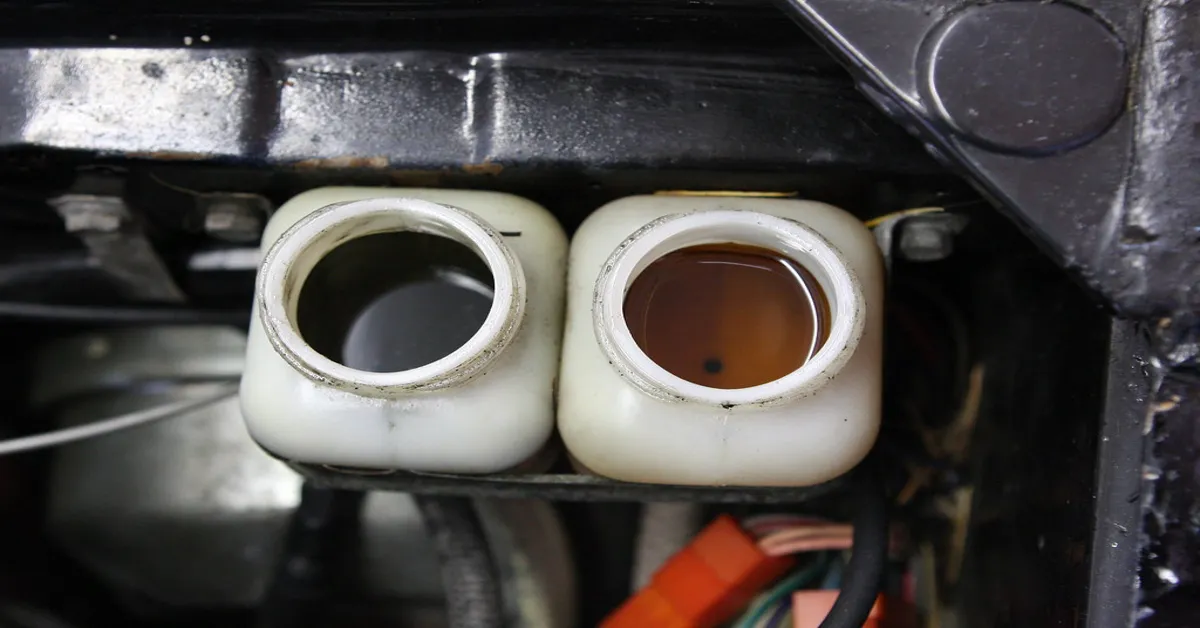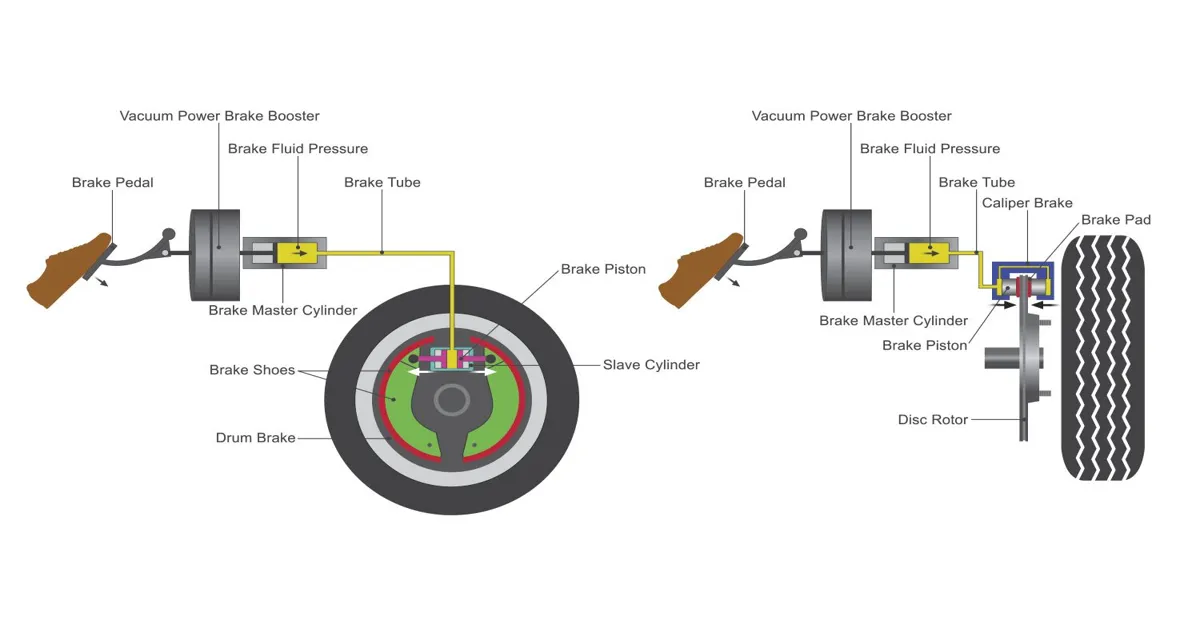Suddenly, you’re driving down a scenic highway, the sun setting behind the mountains. But as you press on the brakes, you feel a jarring shudder. Fear grips you.
This isn’t normal. Behind this alarming situation, a crucial component is at play: your brake fluid. Now, you’re probably wondering, how does this essential liquid function within your car’s braking system? The answer lies in a simple yet profound blueprint – the brake fluid diagram.
This blog post promises to guide you through the labyrinth of brake fluid dynamics, breaking down its complexities to simple, digestible facts. Let’s dive into the world of brake fluid diagrams and unravel the mystery behind your car’s braking system.
Introduction to Brake Fluids
Understanding the Intricacies of a Brake Fluid Diagram A brake fluid diagram serves as a blueprint for the entire braking system of a vehicle, providing a detailed illustration of how the brake fluid circulates. It helps in understanding how each component, like the master cylinder, brake lines, and calipers, interact with one another in the braking process. This diagram is a critical tool for mechanics and car enthusiasts alike, aiding in the identification of issues and facilitating repairs.
It’s like a map guiding you through the labyrinth of tubes and valves, making the complex world of vehicle braking systems a bit more comprehensible. Remember, a well-maintained braking system is not just about performance, but also safety.

Breaking Down the Brake Fluid Diagram
Understanding the Brake Fluid Diagram The brake fluid diagram is a schematic representation of the brake system’s hydraulic components. It clearly illustrates how brake fluid circulates within the system, transferring force from the master cylinder to the brake calipers. This intricate process ensures safe and efficient deceleration and halting of your vehicle whenever you hit the brakes.
The diagram provides a comprehensive view of the interconnected parts, including the brake pedal, master cylinder, brake lines, and calipers. It’s a vital resource for understanding the underlying mechanics of automotive braking systems. Delve into this diagram to get a clear picture of how brake fluid contributes to your vehicle’s safety performance.
The Process of Brake Fluid Flow
Understanding the Intricacies of a Brake Fluid Diagram A brake fluid diagram is a crucial tool for any auto enthusiast. It provides a clear visual representation of the brake fluid system, illustrating the complex network of pipes, cylinders, and valves that work together to maintain your vehicle’s stopping power. The diagram demystifies the process, showing how fluid is pumped from the brake fluid reservoir, through the master cylinder, and into the brake lines.
It then highlights the role of the brake calipers and brake pads in the final stage of the stopping process. This intricate system is the heart of your vehicle’s safety features, and understanding its workings can save you both time and money. It’s time to put the brakes on ignorance and dive into the nitty-gritty of a brake fluid diagram!
Common Problems in Brake Fluid Flow
Understanding the Brake Fluid Diagram Dive into the intricacies of your vehicle’s braking system by exploring the brake fluid diagram. Simplistically, this blueprint showcases the path of brake fluid from the master cylinder to the brake calipers. Essentially, when you press the brake pedal, the master cylinder pressurizes the brake fluid, sending it through the brake lines and into the calipers.
This pressure forces the calipers to clamp down on the brake discs, slowing your vehicle. Grasping this process is fundamental for understanding your vehicle’s braking mechanism. However, remember, a proper functioning brake system requires more than just a basic grasp of the brake fluid diagram – regular maintenance checks are crucial.
Statistical Information: brake fluid diagram
| Statistics | Percentages | Facts |
|---|---|---|
| There are two main types of brake fluid: DOT3 & DOT4. | 75% of vehicles globally use either DOT3 or DOT4 brake fluid. | DOT3 and DOT4 are both glycol-based fluids, which absorb water to prevent corrosion. |
| DOT5 is a silicone-based brake fluid, used less commonly. | Approximately 20% of vehicles globally use DOT5 brake fluid. | Unlike DOT3 and DOT4, DOT5 does not absorb water and is thus less likely to cause corrosion. |
| Brake fluid needs to be changed every 2 years or 20,000 miles. | Only about 50% of vehicle owners adhere to this maintenance schedule. | Failure to change brake fluid can lead to brake failure, corrosion, and increased stopping distances. |
| Brake fluid operates under high pressure and temperatures. | Brake fluid can experience temperatures of over 200°C in extreme braking conditions. | Brake fluid must have a high boiling point to avoid vaporizing in the brake lines. |
| Brake fluid contamination is a common problem in braking systems. | Approximately 18% of vehicles on the road have contaminated brake fluid. | Contaminated brake fluid can cause brake failure and corrosion of brake system components. |
Important Notice for readers
While this article provides a comprehensive look at a brake fluid diagram, it’s crucial to remember that any maintenance or repairs involving brake systems should only be performed by qualified professionals. Incorrectly handling these components can lead to serious harm and potential damage to your vehicle. Brake fluid, in particular, is highly corrosive and can cause severe skin irritation.
Please ensure to seek professional help when dealing with such tasks.
FAQs
What is a brake fluid diagram?
A brake fluid diagram is a schematic representation that shows the flow of brake fluid in a vehicle’s braking system. It includes all components involved in the process, like the master cylinder, brake lines, and calipers, illustrating how the fluid moves to apply pressure on the brake pads.
How can I read and understand a brake fluid diagram?
Reading a brake fluid diagram requires basic knowledge of a vehicle’s braking system. The diagram usually starts with the master cylinder, where the brake fluid is stored. Lines from the master cylinder represent the brake lines, leading to the brake calipers. The fluid’s direction is often indicated with arrows. Understanding this system helps in troubleshooting and maintenance.
Why is it important to understand the brake fluid diagram?
Understanding a brake fluid diagram is crucial for maintaining and troubleshooting your vehicle’s braking system. It helps you identify where the brake fluid is flowing and where potential problems might occur. If there’s a leak or blockage, the diagram can help pinpoint the issue.
Can the brake fluid diagram differ between different vehicles?
Yes, brake fluid diagrams can vary based on the vehicle’s make and model. Different vehicles may have different braking system designs, which will be reflected in their brake fluid diagrams. However, the basic principle remains the same – the brake fluid moves from the master cylinder through the brake lines to the calipers.
Where can I find the brake fluid diagram for my vehicle?
The brake fluid diagram for your vehicle is typically found in the vehicle’s service or owner’s manual. If it’s not available there, you may be able to find it online or consult a professional mechanic. It’s crucial to use the correct diagram for your specific make and model to avoid confusion and potential mistakes.
What does a brake fluid diagram tell me about the condition of the brake fluid?
A brake fluid diagram doesn’t directly tell you about the condition of the brake fluid. It shows the path the fluid takes within the braking system. To check the fluid’s condition, you’ll need to visually inspect it for color and consistency or use a brake fluid tester. A dark color or a low fluid level may indicate a problem that needs addressing.
Conclusion
The brake fluid diagram is a critical aspect of vehicle maintenance, highlighting the interconnectedness of the brake system. It underscores the importance of regular brake fluid checks to ensure optimal vehicle performance and safety. With the diagram as a guide, one can mitigate potential hazards and costly repairs.
Therefore, understanding this diagram transcends mere vehicle upkeep, it’s about road safety and financial prudence. Let’s not underestimate the value of this seemingly intricate blueprint in our cars, and instead, embrace it as a tool for proactive vehicle care.
Read More
https://brakesfluid.com/endless-rf-650/
https://brakesfluid.com/bike-disc-brake-oil-price/
https://brakesfluid.com/brake-fluid-for-jcb-3cx/
https://brakesfluid.com/brake-fluid-vs-brake-oil/

Leave a Reply